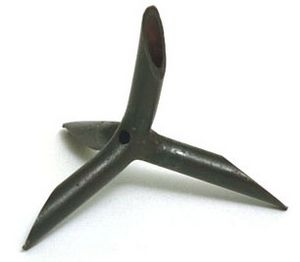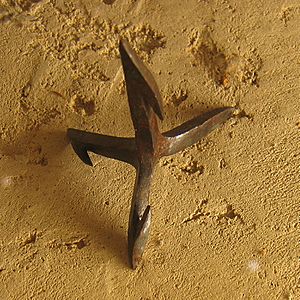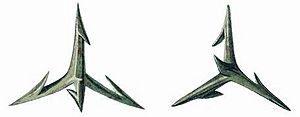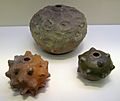Caltrop facts for kids

Caltrops are small, spiky weapons designed to stop people, horses, or vehicles. They have been used for thousands of years, dating back to Roman times. Later versions were made to flatten car tires. They are a type of weapon used to stop enemies from moving forward. In Japan, samurai warriors used a similar weapon called a makibishi.
A Spiky History
Caltrops made of iron were first used around 331 BC at the Battle of Gaugamela. The Romans called them tribulus, which means 'jagged iron'. They also used them in the Battle of Carrhae in 51 BC.
Roman Tactics
A Roman writer named Vegetius wrote about caltrops in his book De Re Militari. He explained how Roman soldiers dealt with enemy war chariots that had sharp blades attached. These chariots were scary at first. But the Romans learned to stop them.
Vegetius said that chariots needed flat ground to move well. If a horse pulling a chariot was hurt, the chariot would stop. Roman soldiers found a clever way to make these chariots useless. They scattered caltrops on the battlefield. When the horses ran over them, they would get injured and stop. A caltrop has four spikes. No matter how it lands, one spike always points upwards.
Caltrops in Modern Times
In more recent history, caltrops were used during World War II by both sides. They were thrown onto roads to puncture the tires of enemy vehicles. This would slow down or stop their movement.
Sometimes, people have made their own caltrops. These are often made from welded nails. They have been used to damage vehicle tires. These homemade devices are sometimes called jack rocks. For example, in 2012, some people were accused of using jack rocks during a protest at a factory in West Virginia.
Images for kids
-
Traditional and explosive caltrops from the Mongol Empire.
-
These "crow's feet" boards had spikes to stop enemies. This one was used by the Russian Army during the Battle of Balaclava.
-
Exploding gunpowder caltrops from the Yuan Dynasty.
See also
 In Spanish: Abrojo (arma) para niños
In Spanish: Abrojo (arma) para niños






